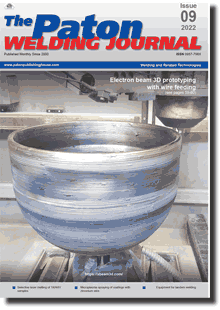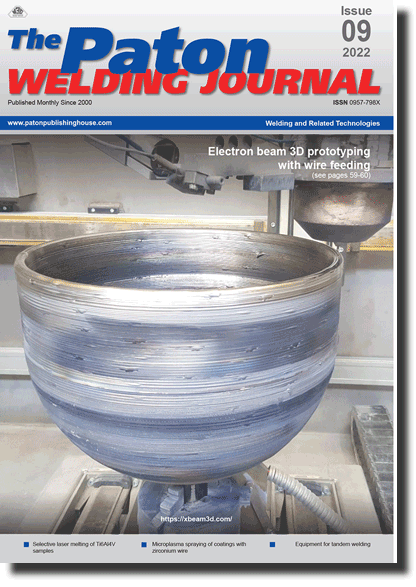| 2022 №09 (05) |
DOI of Article 10.37434/tpwj2022.09.06 |
2022 №09 (07) |

The Paton Welding Journal, 2022, #9, 33-40 pages
Mathematical model of determination of residual stresses and strains in friction stir welding of aluminium alloy
B.R. Tsaryk, O.F. Muzhichenko, O.V. Makhnenko
E.O. Paton Electric Welding Institute of the NASU. 11 Kazymyr Malevych Str., 03150, Kyiv, Ukraine. E-mail: makhnenko@paton.kiev.ua
Abstract
A rater simple and efficient mathematical model of the process of friction stir welding (FSW) was developed, which is focused on fast determination of residual welding stresses and strains with engineering precision. The model is based on application of the method of thermoelastoplastic deformation of the material, which is used at modeling of arc welding, but instead of the model of arc heat source a model of heat evolution from the working tool friction against the material of the joint element was developed. The model also takes into account the conditions specific to FSW of rigid restraint of the joint elements during welding. The developed FSW model was used to conduct calculations of a butt joint of plates from AMg6 aluminium alloy and to present the results of the characteristic distribution of residual stresses and plastic strains, compared to arc welding of the butt joint. Calculation results derived using the developed model confirm the conclusions of other researchers that at FSW of aluminium alloys undesirable residual stresses and strains also form, but they are lower than with the traditional arc welding methods. Developed model can be effectively used for on-line calculation definition of residual stresses and plastic deformations in the zone of welded joints produced by FSW, with the purpose of further assessment of welded joint strength or prediction of general deformations of large-sized structures. Ways of further improvement of the developed model were outlined with the purpose of further increase of prediction accuracy, also by allowing for degradation of mechanical properties (softening) the aluminium alloy during heating.14 Ref., 1 Tabl., 7 Fig.
Keywords: friction stir welding, aluminium alloy, residual stresses, plastic deformation, mathematical modeling
Received: 09.06.2022
Accepted: 11.11.2022
References
1. İpekoğlu G., Akçam Ö., Çam1 G. (2018) Effect of plate thickness on weld speed in friction stir welding of AA6061-T6 Al-alloy plates. The Paton welding J., 12, 7-11. https://doi.org/10.15407/tpwj2018.12.082. Krasnovsky K., Khokhlova Yu.A. and Khokhlov M.A. (2019) Influence of tool shape for friction stir welding on physicomechanical properties of zones of welds of aluminium alloy EN AW 6082-T6., Ibid., 7, 7-12. https://doi.org/10.15407/tpwj2019.07.02
3. Riahi, M., Nazari, H. (2011) Analysis of transient temperature and residual thermal stresses in friction stir welding of aluminum alloy 6061-T6 via numerical simulation. Int. J. Adv. Manuf. Techn., 55, 143-15. https://doi.org/10.1007/s00170-010-3038-z
4. Ferro, P., Bonollo, F. (2010) A semi-analytical thermal model for friction stir welding. Metallurg. and Mater. Transact. A, 41, 440-449. https://doi.org/10.1007/s11661-009-0104-y
5. Majstrenko, A.L., Nesterenkov, V.M., Dutka, V.A. et al. (2014) Modeling of thermal processes for improvement of structure of metals and alloys by friction stir welding. In: Proc. of 7th Int. Conf. (Ukraine, Odessa, 15-19 September).
6. Aziz Saad, B., Dewan Mohammad, W., Huggett, D.J.et al. (2016) Impact of friction stir welding (FSW) process parameters on thermal modeling and heat generation of aluminum. Acta Metall. Sin. https://doi.org/10.1007/s40195-016-0466-2
7. Andrade, D.G., Leitão, C., Dialami, N. et al. (2020) Modelling torque and temperature in friction stir welding of aluminium alloys. Int. J. Mech. Sciences, 182. https://doi.org/10.1016/j.ijmecsci.2020.105725
8. Dresbach Christian, Marinus J. van Enkhuizen, Ulises Alfaro Mercado, Stefan Reh. (2014) Simulation of thermal behavior during friction stir welding process for predicting residual stresses. CEAS Aeronaut J. https://doi.org/10.1007/s13272-014-0145-9
9. Meyghani, B., Awang, M., Emamian, S., Khalid Nor M. (2017) Developing a finite element model for thermal analysis of friction stir welding by calculating temperature dependent friction coefficient. In: 2nd Int. Conf. on Mech., Manuf. and Process Plant Engin., 107-126. DOI 10.1007/978-981-10-4232-4_9 https://doi.org/10.1007/978-981-10-4232-4_9
10. Makhnenko, O.V. (2008) Combined application of method of thermoplasticity and method of shrinkage function for studying of hot straightening of shipbuilding panels. Matematychni Metody ta Fizyko-Mekhanichni Polia, 51(4), 193-201 [in Russian].
11. Nandan, R., Roy, G.G., Lienert, T.J., DebRoy, T. (2007) Three-dimensional heat and material flow during friction stir welding of mild steel. Acta Materialia, 55, 883-895. https://doi.org/10.1016/j.actamat.2006.09.009
12. Ishchenko, A.Ya., Podielnikov, S.V., Poklyatsky, A.G. (2007) Friction stir welding of aluminium alloys (Review). The Paton Welding J., 11, 25-30.
13. Makhnenko, V.I. (1976) Calculation methods for study of kinetics of welding stresses and strains. Kyiv: Naukova Dumka [in Russian].
14. Beletskij, V.M., Krivov, G.A. (2005) Aluminium alloys (composition, properties, technology, application). Kyiv, Comintekh [in Russian].
Suggested Citation
B.R. Tsaryk, O.F. Muzhichenko, O.V. Makhnenko (2022) Mathematical model of determination of residual stresses and strains in friction stir welding of aluminium alloy. The Paton Welding J., 09, 33-40.The cost of subscription/purchase order journals or individual articles
| Journal/Currency | Annual Set | 1 issue printed |
1 issue |
one article |
| TPWJ/USD | 384 $ | 32 $ | 26 $ | 13 $ |
| TPWJ/EUR | 348 € | 29 € | 24 € | 12 € |
| TPWJ/UAH | 7200 UAH | 600 UAH | 600 UAH | 280 UAH |
| AS/UAH | 1800 UAH | 300 UAH | 300 UAH | 150 UAH |
| AS/USD | 192 $ | 32 $ | 26 $ | 13 $ |
| AS/EUR | 180 € | 30 € | 25 € | 12 € |
| SEM/UAH | 1200 UAH | 300 UAH | 300 UAH | 150 UAH |
| SEM/USD | 128 $ | 32 $ | 26 $ | 13 $ |
| SEM/EUR | 120 € | 30 € | 25 € | 12 € |
| TDNK/UAH | 1200 UAH | 300 UAH | 300 UAH | 150 UAH |
| TDNK/USD | 128 $ | 32 $ | 26 $ | 13 $ |
| TDNK/EUR | 120 € | 30 € | 25 € | 15 € |
AS = «Automatic Welding» - 6 issues per year;
TPWJ = «PATON WELDING JOURNAL» - 12 issues per year;
SEM = «Electrometallurgy Today» - 4 issues per year;
TDNK = «Technical Diagnostics and Non-Destructive Testing» - 4 issues per year.


